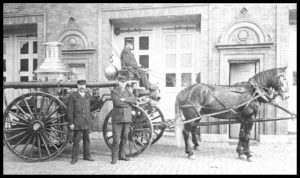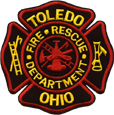Today, August 12, 2016, marks the 100th anniversary of the last fire horse being retired from service on what was then called the Toledo Fire Department. The last Toledo fire horse was located at fire station 15, which at the time, was at Airline and Gibbons Streets in the south end. By that point in time our department was completely motorized.
The following is an article from the Summer 1994 issue of “The Hook & Letter”, a newsletter produced by the Toledo Firefighters Museum and was  written by Bill O’Connor, a retired Fire Captain.
written by Bill O’Connor, a retired Fire Captain.
The era of the fire horse lasted roughly fifty years, from the end of the Civil War until the end of 1915. More time and expense was incurred buying one fire horse than ten firemen.
Fire horses came in three classifications: The lightweight (1,100 pound horses that were used on the hose wagons), the middleweight (1,400 pound horses that were used on the steamers) and the large, 1,700 pounders that were used to pull the hook and ladders as well as other heavy equipment. Fire horses required much stamina and strength and natural ability. One expert of the time said it was usually a one-in-a-hundred selection. Their training took between one and two years. The City of Detroit actually had a horse college where many of Toledo’s horses were trained.
The Harrison family of the City of Toledo were involved in the training and purchasing of many of Toledo’s fire horses.
Once a horse was selected, he was then assigned a station and then given a number. This number stayed with him throughout his career, which usually lasted from four to eight years.
Once he entered the station, he was assigned to a team and usually given a name. The in-station training took many hours in training stalls, getting used to the quick hitches and the sound and ringing of gongs and registers. These processes had to be repeated many times with much praise and rewards from the trainer, until he became part of the team.
 Fire horses were not only part of the fire house, but were a part of the neighborhood. Children of the area, on weekends, would bring them treats like apples and sugar cubes. They often would get to ride in the exercise wagon with a fireman.
Fire horses were not only part of the fire house, but were a part of the neighborhood. Children of the area, on weekends, would bring them treats like apples and sugar cubes. They often would get to ride in the exercise wagon with a fireman.
Many of the firemen of the day said the horses received much better care than the firemen. Their medical needs were attended regularly by the city’s veterinarian.
The fire stations in this era were usually built two miles apart as they figured a responding first alarm company could answer an alarm within five or six minutes.
Many of the books I have read on the fire horse claim that the fire horse loved the fire department as much as the men did. Some men claimed the horses actually could count the number of gongs their station responded to and while on the way to a fire, the first hint of smoke in their nostrils made their excitement grow.
It took a special man to handle these temperamental teams, a man who had strong but gentle hands, one that the team he was driving would respond to his every move.
In closing, I would have to say that this was the most picturesque and exciting era of firefighting. The last Toledo horse ran out of #15 Fire Station at Airline and Gibbons on August 12, 1916.
